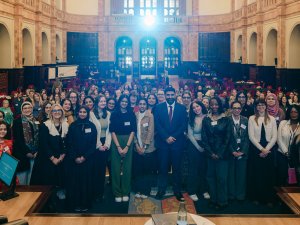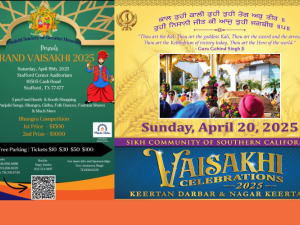Hermeneutics of Divine Soundscapes
Hermeneutics is a science with rules of discipline for the study, theory, and interpretation of theology, and the language used in religious scripture. The term originates from the Greek word hermēneutikos, which translates to “expert in interpretation.” Hermeneutics interpretation of Gurbani kirtan strives to decode the musical signatures of 31 Raags of Guru Granth Sahib to understand the historical, cultural, and literary context of raag, by making observations that can be applied to discover meanings embedded in texts and to decode and understand the truths and values it imparts. The International Kirtan Conference examined a wide perspective of the historical, modern, and future aspects of Raga Kirtan.
I observed the International Kirtan Conference Webinar opening presentation held in the final week of October 2024, at the Punjabi University, Patiala, with the collaboration of Nad Music Institute, USA through webinar. I felt privileged to be an attendee, especially as I had previously met several participants in person, by phone, or by email. The webinar was attended presentially in Patiali by Amanpreet Singh SikhNet Analytics Director and Jagjeevan Singh SikhNet Play director (pictured above), they very much enjoyed meeting and discussing with people on the ground there.
Garlands of fresh orange-colored Chrysanthemums strung along the front of the speaker's table and podium, and hung just behind on the back wall, added a festive touch to the stage. A large banner featuring a photo of Bhai Hira Singh Ragi and the conference topic hung from the wall.
The Webinar presentations flowed from English to Punjabi. Most speakers spoke entirely in Punjabi, with some using English language slides that enabled me to grasp the topic. Meanwhile, the webinar AI subtitles Closed Captioning typed out hilarious phrases when attempting to render Punjabi as English by using similar-sounding English words. (For example, “Okay, Dude, no Yeah,” and “Phantom Piggy,” are just a couple of silly excerpts from ongoing AI CC subtitle nonsense that proved somewhat entertaining providing comic relief, but ultimately making me wish that I understood Punjabi much better.) Punjabi speakers, completely unaware, spoke very seriously on their topics. I understood little of the Punjabi presentations, but still, I enjoyed learning considerable information. I dealt with a 12.5-hour time difference, but the sincerity of the live webinar speakers’ presentations, regardless of the language spoken kept me riveted through the wee hours.
Raga Kirtan took place each evening, however the webinar did not include any performances.
Day 1 Oct 21, 2024 - Inaugural Session
11:00 am – 1:00 pm
Welcome delivered in Punjabi by Dr. Jaswinder Singh, in charge, of Bhai Vir Singh Chair, Punjabi University, Patiala.
Key Note Lecture presented in English and Punjabi by speaker Sarabpreet Singh, founder of Gurmat Sangeet Project USA. Sarabpreet Singh spoke of his experiences and shared that he grew up in Bangkok, cherished everything Western, and thought everything Indian to be inferior. “At some point, something inspires you to search your roots,” he remarked. He went on to say that in 1987, non-Sikhs' reactions to the horrific incidents of 1984 sparked that interest. He became curious about Sikhi at about age 25. Because of his upbringing, he could not read Gurmukhi, so he had to read about Sikh History in English. [A sentiment/predicament many Western-born, Sikhs share who are not of Punjabi origin.] He told how met the late Vikram Singh Khalsa [Antion Meredith] of the Rock Band Animals while in the UK, adding a new and intriguing dimension to his budding attraction to his Sikh heritage. He became more involved as time passed, and ultimately his interest drew him to the Raag of Gurbani.
Special Guest appearance by S. Divjyot Singh (great-grandson of Bhai Hira Singh Ji Ragi), Founder and Managing Director, Alaya Legal, Advocates, New Delhi.
Guest of Honor appearance by Bhai Maninder Singh, Hazuri Ragi Sri Darbar Sahib, Sri Amritsar.
Presidential remarks in Punjabi by Prof. N.K. Multani, Dean of Academic Affairs, Punjabi University, Patiala.
Vote of Thanks appearance by Dr. Manjit Singh, Director, Nad Music Institute, USA.
Technical Session I
2:00 pm – 4:30 pm
Live Appearances
Chair Dr. Gurnam Singh, Ex-Dean Academic Affairs and Head of Gurmat Sangeet Department, Punjabi University, Patiala.
Co-Chair appearance by Dr. Lakhwinder Singh, Assistant Director, DAH, Punjab & Traditional Gurbani Kirtan Practitioner.
Guest of Honor appearance by S. Karanvir Singh Sibia, Founder of Rabab e Ruhaniyat.
Special Lecture presented in Punjabi with slides by Dr. Manjit Singh, Director of Nad Music Institute, USA, who spoke on Ghar in Gurbani [ghar can mean habitation, home, house, or heart].
Speakers and Topics
Speakers presented papers and demonstrated examples of various musical methodologies. Presentations included live in-person appearances and live appearances projected on a screen.
- Parthaals, Rhythmic Patterns, in Sri Guru Granth Sahib presented in Punjabi by Dr. Tajinder Pal Singh, Khalsa College, Patiala
- ਗੁਰੂਨਾਨਕ ਬਾਣੀ ਵਿਚਲੇਰਾਗਾਂਵਿਚ ਸੁਰਾਂਦੇਵਕਰ ਚਲਨ ਦਾ ਸਰੂਪਗਤ ਅਧਿਐਨ: Raag of Guru Nanak Dev Bani presented in Punjabi by Tejinder Kaur, GCW College, Patiala.
- Secrets of Sacred Sound presented in Punjabi by S. Anurag Singh, Independent Researcher, Ludhiana. [Such an intriguing title, I would have loved to have understood this presentation!]
- Exploring the Raags in the Guru Granth Sahib, presented deliberately and clearly in English by Sukhmann Kaur and Muktnoor Kaur, Sikh Research Institute (USA). The topic included a review of the conditions that influenced the various Raags of Gurbani.
- Raag Majh, and Raag Asa: Historical, regional, and colloquial aspects.
- Raag Gujari: Cultural influences.
- Raag Suhi and Raag Maru: Historical, cultural, and emotional aspects.
- Raag Basant, Raag Sarang, Raag Malhar, and Raag Deepak: Cultural and seasonal influences.
- Raag Kaliyan: Historical and socio-cultural aspects.
- Kirtan for the Sangat in the Digital Age presented clearly and coherently in English by Ek Ong Kaar Khalsa Michaud, Executive Director of SikhNet.com, USA. Her topic focused on the history of Gurbani Kirtan recordings provided by Sikhnet since its inception in 1990’s.
- By 2005, Sikhnet had over 80,000 minutes of Gurbani available online.
- In 2009, Sikhnet launched Gurbani Media with 141,000 minutes of kirtan online.
- In April of 2023, Sikhnet overhauled and upgraded to Sikhnet Play with eight times the Gurbani as previously, or a phenomenal two complete years of listening for 24 hours a day online.
- Preservation of Audio History: Sikhnet became a Repository.
- Sangat Listening Experience: 9,000 people tune in daily to Sikhnet Play compared to Darbar Harmandir Sahib in Amritsar which has 100,000 daily listeners.
- Sikhnet Global Platform:
1) Features current Kirtan artists who will become tomorrow's legacy.
2) Protects the religious rights of Sikhs to share kirtan online in cooperation with the DMCA Copyright Policy.
3) Offers free access online to Kirtan and is completely donor-supported, with no advertising.
October 22, 2024 Day 2- Technical Session II
10:00 am – 1:00 pm
Chair Dr. Jasbir Kaur, Principal. Gurmat College, Patiala.
Co-Chair Dr. Harbhajan Singh, Former Director, Punjabi University Dr. Balbir Singh Sahitya Kendra, Dehradun.
Guests of Honor S. Paramjit Singh, Director, RCED, Chandigarh & Supreme Council Member, SMC, Ludhiana.
Live Presentation Speakers and Papers
- Gurmat Sangeet Without Borders with Kanwaljit Singh, Independent Researcher, Director of Miracle Foundation, New Delhi. Bypassing the barriers of traditional borders, Kanwaljit Singh presented a paper in English. His topics regarding the Evolution of the Gurus included the number of Raags in which each Guru composed Shabads, and focused on:
- The Rababi Tradition
- The Naamdhari Kukas
- Gurmat Sangeet Beyond Kirtankars
- Raag and Traditional String Instruments Beyond Borders
- Understanding the Message Hidden in Bani
- Efforts to Encourage the Singing of Gurbani
- The Essence of Gurmat Sangeet
- Samplings of Rare Recordings by Kirtan Sewa Malaysia on YouTube.
- ਗੁਰਬਾਣੀ ਸਿਰਲੇਖ ਪ੍ਰਬੰਧ Gurbani Sirlaek Praband presented in Punjabi by Dr Gurmail Singh, Head, Guru Gobind Singh Dept. of Religious Studies, Punjabi University, Patiala.
- ਸ੍ਰੀ ਗੁਰੂਗ੍ਰੰਥ ਸਾਹਿਬ ਵਿੱਚ ਦਰਜ ਗਾਇਨ ਸੈਲੀਆਂ : ਇੱਕ ਸੰਗੀਤਕ ਪਰਿਪੇਖ Sri Guru Granth Sahib Vich Daraj Gaain Saieeaan Ik Sangeetak Parpaek presented in Punjabi by Dr Gursimran Kaur, HOD Music Department, SGHS Khalsa College, Ambala. Her presentation included lovely vocal illustrations of various styles.
- Short presentations given in Punjabi by Dr. Harbhanjan Singh and others. Dr.Harbhanjan Singh honored various speakers with Saropa while the photographer took photographs.
- Presentation with Vocal illustrations by Dr. Jasbir Kaur of Gurmat College in Patiala, accompanied by a strummed string instrument.
Technical Session III
2:00 pm – 4:30 pm
Chair Dr. Gurnam Kaur Bedi, Retd. Principal, GCW, Sri Amritsar.
Co-Chari Dr. Alankar Singh, Head, Gurmat Sangeet Department and Music Department, Punjabi University, Patiala.
Guests of Honor Principal Sukhwant Singh, Baba Sucha Singh Gurmat Sangeet Academy, and Sur
Abayas Kender, Jandiala Guru, Amritsar.
Keynote Lecturer by Dr. Francesca Cassio, Professor & Chair, Music Department, and Sardarni Harbans Kaur Chair in Sikh Musicology, Hofstra University, USA. Presented live on screen in English, her topic Critical Listening included photographs of the renowned Bhai Baldeep Singh and covered the subjects:
- Repositioning Gurbani Kirtan.
- Disciplinary research in pre-colonial context. What Raags and Musical Signatures tell us about the oral culture in which the Gurus lived.
- The Importance of listening in an oral culture, and remapping pre-colonial traditions.
- Listening to the Guru’s teachings depended on one's ability to listen, rather than one's social status and educational opportunities to learn to read.
- Prabandha, a song of praise to a deity or royal patron is considered to be the origin of the dhrupad compositional structure.
- Pada is a poem meant to be sung.
- A Vaggeyakara composes both verbal and melodic rhythmic structures of a song.
- Dhrupada includes the name of the composer in the final line.
- Pada Pradhan kirtan is a parallel entity rather than a derivative form of music.
- Samaj Gayan, the congregation sings in a responsive form.
- Dhrupad of the Vaisnava tradition served the worship of God rather than a worldly form of music.
- Pada in Gurbani is a distinct musical and poetical song form. Pada refers to a music style with a refrain rather than a simple repetitive chant.
- Raga is a template for melody and is likely linked to court composers. Gurbani kirtan appears to have been established before Dhrupad. Raga-based songs in Guru Granth reflect the multicultural ground of premodern era Punjab.
- The inclusive nature of Sikh Scripture played an important part in retaining the collective memory of repertories sung across South Asia between the 12th and 17th centuries. Without the contribution of the Sikh tradition South Asian history is incomplete.
- The headings and musical signatures of Guru Granth Sahib reveal the ecology of voices and songs that the Sikh Gurus heard and reproduced.
Live Presentation Speakers and Papers
- ਗੁਰਬਾਣੀ ਕੀਰਤਨ ਪੁਰਾਤਨ ਪਰੰਪਰਾ: Rababi Kirtan Puraatan Parnparaa presented in Punjabi by S. Harbhajan Singh Dhariwal, Senior Research Fellow, Nād Music Institute (USA), Gurdaspur
- ਗੁਰੂਗ੍ਰੰਥ ਸਾਹਿਬ ਵਿਚ ਦਰਜ ਰਾਗਾਂਸੰਬੰਧੀ ਵੱਖ-ਵੱਖ ਸਰੋਤਾਂਵਿਚੋਂਪ੍ਰਾਪਤ ਅੰਤਰ ਦ੍ਰਿਸ਼ਟੀਆਂ: Guru Granth Sahib Vich Daraj Raagaansanbandhee Vakh-Vakh Sarotaanvichpraapat Antar Dristteeaa presented in Punjabi by Dr. Jaswant Singh, Dr. Sohan Singh, Sikh Research Institute (USA), Mohali.
- Guru Granth Sahib Project Research| Meaning |Commentary
ਸ੍ਰੀ ਗੁਰੂਗ੍ਰੰਥ ਸਾਹਿਬ ਵਿਚ ਦਰਜ ਰਾਗ: Sri Guru Granth Sahib Vich Daraj Raag presented in Punjabi with some English notes with slides, by Sukhwinder Singh and Prof. Kartar Singh Gurmat Sangeet Academy, Sri Anandpur Sahib, who spoke on the Guru Granth Sahib Project making Guru Granth Sahib accessible to all through AI. The subjects of his slides included:
- Shabd te Raag da Sumael (Shabad and Raag are well matched).
- ਰਾਗ ਨਾਦ ਸਬਦਿ ਸੋਹਣੇ ਜਾ ਲਾਗੈ ਸਹਜਿ ਧਿਆਨੁ ॥
Raag naad sabd sohnnae jaa laagai sahej dhiaan ||
The melody, music, and the Word of the Shabad are beautiful when one focuses his meditation on the celestial Lord. SGGS Ang 849
- Punjab and Rajasthan had great love for Gurbani.
- The various Raags originated in specific regions during specific eras.
- ਸਭਨਾ ਰਾਗਾਂ ਵਿਚਿ ਸੋ ਭਲਾ ਭਾਈ ਜਿਤੁ ਵਸਿਆ ਮਨਿ ਆਇ ॥
Sabna raagaan vich so balaa bhaee jit vasiaa man aae ||
Among all Ragas, that One is sublime, O Siblings of Destiny, by which the Lord comes to abide in the mind. SGGS ANG 1423.
- Connect with the Shabad and allow it to strengthen your mind and heart.
- Mapping Multiplicity, The Complex Soundscape of the Golden Temple presented rapidly in English by Dr. Janice Protopapas, Ethnomusicologist in Sikh Music, USA. She delivered a discussion on her topic, Political and Economic Influences on The Environments of Structural Soundscape with slides that included an interesting perspective comparing types of listening and singing experiences:
- ਇਕ ਦੂ ਜੀਭੌ ਲਖ ਹੋਹਿ ਲਖ ਹੋਵਹਿ ਲਖ ਵੀਸ ॥
If I had 100,000 tongues, and these were then multiplied twenty times more, with each tongue
ਲਖੁ ਲਖੁ ਗੇੜਾ ਆਖੀਅਹਿ ਏਕੁ ਨਾਮੁ ਜਗਦੀਸ ॥
I would repeat, hundreds of thousands of times, the Name of the One, the Lord of the Universe. Text from Japji Pauri 32, SGGS Ang 7
- A comparison of Kirtan Service at Darbar Harmandir Sahib restricted to 15 Jathaas examined for excellence in kirtan, where no woman may perform.
- Chaunki Sahib, a comparison of, the practice of walking in sound around the Parkarma of the Sarovar while singing.
- Sound space layered with multiplicities of memories.
ਸਜਣ ਸੇਈ ਨਾਲਿ ਮੈ ਚਲਦਿਆ ਨਾਲਿ ਚਲੰਨਿੑ ॥
They alone are my friends who travel along with me,
ਜਿਥੈ ਲੇਖਾ ਮੰਗੀਐ ਤਿਥੈ ਖੜੇ ਦਿਸੰਨਿ ॥੧॥ ਰਹਾਉ ॥
and in that place, where the accounts are called for, they appear standing with me. ||1||Pause|| SGGS Ang 729
- The final comparison is to Thara Sahib, a dodecagon-shaped gurdwara with 12 sides, where everyone can sing without restrictions to the type of kirtan. No knowledge of raag is required. Each sound is history enacted.
- A technical issue resulted in a change of program. In a projected live performance, an unidentified person dressed in grey gave intriguing vocal illustrations of Raag at the close of the conference.
October 23, 2024 Day -3 Technical Session IV
(10:00 am – 1:00 pm)
Chair S. Sarabpreet Singh (Founder of Gurmat Sangeet Project, USA).
Co-Chair Taranpreet Kaur Mehndi, CEO, DRecords International, New Delhi.
Guest of Honor Dr. Neelam Kaur (Advisor, Health Sciences and Education, The Kalgidhar Trust).
Guest of Honor Ustad Surjeet Singh, World Renowned Sarangi Maestro, United Kingdom.
Special Guest presentation in Punjabi by Bhai Kultar Singh, Bhai Swaran Singh (Hazuri Ragi, Gurdwara Bangla Sahib, and Sis Ganj Sahib, New Delhi).
Special Lecture Sikh Sacred Music Graded Exams presented in the Punjabi language with English slides by Dr. Harjinder Singh Lallie, Director, ACE-CSE, The University of Warwick, UK, and Director of Gurmat Sangeet Academy, UK. SikhSacredMusic.org sets a new internationally recognized standard in Sikh music education. Slides on this topic included:
- Sacred Music Everything You Need for the MTB pre-coverage exam. What is the Sikh Sacred Music Exam?
- Ofqual / UCAS / UK & Internationally recognized
- Target 8 grades plus pre-grade
- Target Ages 8-17, but any age is welcome to learn.
- Test Kirtan on bowed String instruments with Nadharat Raag (Raag of Guru Granth Sahib only)
- The 5 Bowed String instruments are Dilruba, Taus, Iraj, Sarangi, and Tarsehnai.
- Rigor
- Structure and cohesive pathways
- Teach for a purpose to promote Sikh Sacred Music
- Relevance
- OFqual / UCAS/ UK Gov’t recognized
- Reverence
- Valued by learners and tutors
- Preserved for future generations
- A Standardized Bandish Structure has been developed for candidates' examinations.
- FAQS
- Q: Can I learn independently? A: No, you need a teacher to guide you.
- Q: Who is paid? A: You pay MTB directly. No money goes to GSA.
- Q: I am a tutor; can I learn more? A: Yes
- The Future
- Workshops for each grade
- Teacher training
- Tabla Curriculum
Live Presentation Speakers and Papers
- Technological Advancements in Gurmat Sangeet Education presented in Punjabi Language with English slides by Gurcharan Singh, Manmeet Singh, Livtaar Gurmat Sangeet Academy, Bangalore.
Subjects and slides on this topic included:
- Learn and Teach Gurbani Kirtan Online
- Remote Learning Anywhere
- Live Progress updates
- Self-paced learning
- Curated content
- Regularly updated
- Personalized mentorship
- Learning pathway
- Asthaee & Shabad
- Zoom, WhatsApp, GSuite, & Paypal
- Empower teachers
- Develop deeper content
- Design & Development in other areas of Sikhi and Life.
- Celebrating the Female Voice in Gurbani Kirtan, A Journey of Passion and Purpose beautifully presented in clearly spoken English and Punjabi, with a backdrop of the Golden Gate Bridge, by Navpreet Kaur (GAAVANI), USA, who portrayed the divine connection between the singer and Shabad. Subjects and slides on this topic included:
- Mentorship & Inspiration
- 31 Raags with Bhai Nirmal Singh & Dr Gurnaam Singh
- GAAVANI Core Values Sing & Understand
- Guru Shabad as the source of wisdom
- Female expression is divine
- Music as a gateway for connection
- Preserve & Celebrate
- Vision: Kirtan in every home
- Mission: Empower the Female Voice & Spirit
- Sing Connect & Reflect:
- Shabad Art increases the connection with Shabad Culture
- USA EAST to WEST California, Texas, and New Jersey Performances
- Come away with a GAAVANI Glow
- All Ages, Grandmothers, Mothers, and Daughters
- The future is to take GAAVANI internationally.
- Internationally Celebrated and Renowned Kirtaniya
- ONENESS Movement to clear a path for women to connect through kirtan and encourage future generations to connect through kirtan with supportive sangat from Brothers / Singhs.
- श्री गुरु ग्रंथ साहिब मेंधुन की प्रासंगिकता: presented in Hindi & Punjabi by Dr. Paramjeet Kaur, SD College, Ambala. Shabad of Siri Guru Granth Sahib Raag Notation / Bandish Structure.
- The Science and Art of Kirtan Aligning with the Guru’s Path presented in Punjabi by S. Surinder Singh, Founder, Raj Academy, UK.
- Gurbani Kirtan Learning Manual presented in the Punjabi language, with English slides, by Jasnoor Kaur, Nad Music Institute (USA) Fellow, Dubai. The slides included the subjects:
- Learning Gurbani Kirtan Online & Offline
- Online facilitates learning remotely.
- Challenges with Learning
- Quality Education
- Time and convenience
- Finance
- Gurbani Kirtan Manual (GMK) all in one package. The purpose is to reach students who wish to learn kirtan but have no teacher.
- 29 weeks of lessons
- Videos available.
- Separate Audio Files available for shabads.
- Basics of Gurbani Kirtan
- Relevant Theory Papers
- Illustrations and instructions for Harmonium
- Certified by Naad Music Institute free of charge
- Uniquely targeted to young beginners
- Interactive video lessons
- Fun Quiz
- 29 weeks of homework
- Learning Gurbani Kirtan Online & Offline
- Musical Hermeneutics of Bhai Vir Singh: Understanding Sabad Kirtan presented in Punjabi by Dr. Jaswinder Singh, Incharge, Bhai Vir Singh Chair & Gurdial Singh, ICSSR Research Fellow, GGS Dept. of Religious Studies, Punjabi University, Patiala
- The Journey of Learning Gurbani Kirtan and Ragas in Guru Granth Sahib presented in Punjabi by Saleema Khawaja, Gurbani Kirtan Practitioner and Lawyer, Pakistan.
- Spiritual Aspects of Kirtan, Raags, and Dhuni presented in Punjabi by Harpreet Singh Khalsa, Edith Cowan University, Australia, and Dilmohan Singh, Independent.
The live Webinar concluded. I came away knowing much more about the different perspectives presented, historical influences on raag, current opportunities for learning raag, and projections for the future regarding raag. I hope the future holds more such conferences, and that in the future, AI will have the ability to translate live so we can all learn even more. I apologize if I have misunderstood anything because of language differences. I wholeheartedly applaud this fantastic effort and all who took part.










